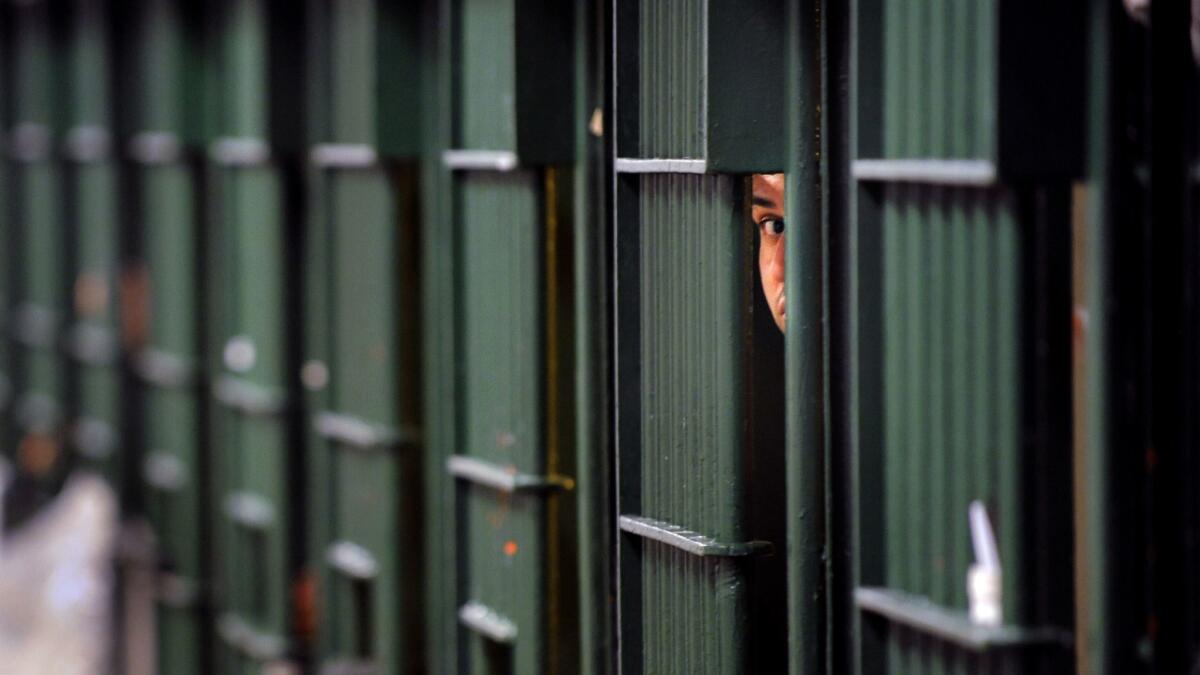Editorial: Psychiatric patients need hospital beds, not jail cells

Los Angeles County leaders often call their jail system the nation’s largest mental hospital, and to our great collective shame, they are correct. The jails are where we dump thousands of people who really ought to be in psychiatric hospitals, community-based rehabilitation programs or supportive housing. Those facilities were supposed to be built decades ago to replace state mental institutions, which too often served as abusive warehouses for society’s sick and unwanted. The state institutions closed on cue — but precious few of the humane, treatment-oriented alternatives were ever built.
So now we “house” much of the mentally ill population on the street, until breakdowns or other crises lead to confrontations and criminal charges. Then they go to jail.
The proportion of L.A. County jail inmates with diagnosed mental health disorders currently hovers at about one in three. That means that more than 5,000 psychiatric patients are locked up in facilities meant to punish crimes or hold dangerous people until their trial dates.
This most progressive Board of Supervisors must end the unconscionable use of jail in place of treatment for the mentally ill.
For years, county leaders have reasoned that if their jails were going to be virtual mental hospitals, they might as well be competent ones. They knew that the decrepit Men’s Central Jail north of downtown L.A., once described by a federal judge as “inconsistent with human values,” must be torn down. So they proposed replacing it with a “Consolidated Correctional Treatment Facility” designed specifically for mental healthcare. In 2015, the Board of Supervisors voted to move forward. But even as they did so, the supervisors showed little enthusiasm, perhaps because of the nagging thought that they were taking the wrong route and could do better. But how?
Just before the jail vote, Dist. Atty. Jackie Lacey presented them with a blueprint for diverting mentally ill arrestees from jail altogether. In response, the supervisors created and funded an Office of Diversion and Reentry.
Meanwhile, activist groups such as Dignity and Power Now and the Youth Justice Coalition have become increasingly effective at articulating the folly — the immorality — of spending money and constructing cells to lock up people who should be in care, not in jail.
What difference does it make, supervisors once asked, whether a patient is treated in a jail staffed with psychiatrists and clinicians or a secure — meaning locked — psychiatric hospital that necessarily includes law enforcement personnel?
But a growing chorus of experts is pointing out that it actually makes a huge difference. In hospitals, patient misbehavior is handled by mental health teams equipped with an assortment of care-oriented responses geared toward improving behavior and encouraging recovery or at least better management of symptoms. In a jail, even one with doctors on hand, sheriff’s deputies with little or no training in psychiatric care respond to misbehavior as they are trained — with force and isolation, both of which generally exacerbate mental illness and produce poor results, including increased recidivism.
Jail or prison will no doubt remain the most appropriate place for some of the most dangerous inmates, and the county has plenty of space in numerous jails. But many patients should be diverted to treatment.
Enter the Fray: First takes on the news of the minute »
In beginning to take on homelessness, the current Board of Supervisors concentrated on a crucial piece of a societal puzzle that had been neglected or mishandled for decades. Now the other pieces are coming into focus, and it is increasingly apparent how intimately they lock together — homelessness, mental health, addiction, public safety and justice.
It’s now time to complete the puzzle.
The supervisors seem to sense the possibilities — and the tragic consequences of thinking too small. Mark Ridley-Thomas ordered a study intended to determine the full potential of mental health diversion from jail. Kathryn Barger called for a needs assessment of mental hospitals and shorter-term reentry care. Hilda Solis is studying an intriguing and innovative restorative care village at the L.A. County-USC medical campus. The board all but killed a plan to lock up female inmates hours away from families and support, and will look for better solutions.
What’s called for now is to say “no” to the mental health jail — and to instead create a road map for real mental healthcare of a scope and at a scale commensurate with the county’s needs. The time for the Consolidated Correctional Treatment Facility has come and gone. This most progressive Board of Supervisors must end the unconscionable use of jail in place of treatment for the mentally ill. It is the great unfinished task of a generation. It is the reason they are here.
Follow the Opinion section on Twitter @latimesopinion and Facebook.
More to Read
A cure for the common opinion
Get thought-provoking perspectives with our weekly newsletter.
You may occasionally receive promotional content from the Los Angeles Times.










